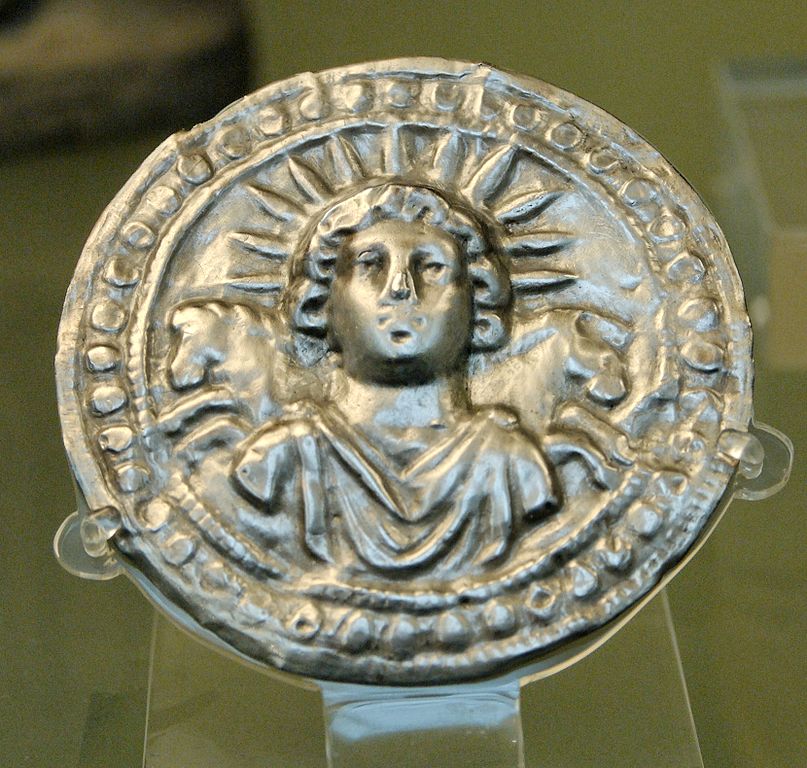Sol Invictus
Sol Invictus (Classical Latin: "Unconquered Sun") was long considered to be the official sun god of the later Roman Empire. In recent years, however, the established views on Sol Invictus have come under sustained attack, and at present the scholarly community is divided on Sol between traditionalists and a growing group of revisionists.
In the traditional view, Sol Invictus was the second of two entirely different sun gods in Rome. The first of these, Sol Indiges, or Sol, was an early Roman deity of minor importance whose cult had petered out by the first century AD. Sol Invictus, on the other hand, was a Syrian sun god, whose cult was first promoted in Rome under Elagabalus, without success. Some fifty years later, on 25 December AD 274, the Roman emperor Aurelian did succeed to establish the cult of Sol Invictus as an official religion, alongside the traditional Roman cults.
Revisionists reject this almost entirely. They claim that the evidence clearly shows that there was only one cult of the Sun God in Rome, continuous from the monarchy to the end of antiquity. This was a Roman god who was simply called Sol. There were at least three temples of the Sun god in Rome, all active during the Empire and all dating from the earlier Republic. There was never a separate solar deity named Sol Invictus, far less a Syrian one.
Aurelian
The Roman gens Aurelia was associated with the cult of Sol. After his victories in the East, the Emperor Aurelian thoroughly reformed the Roman cult of Sol, elevating the sun-god to one of the premier divinities of the Empire. Where previously priests of Sol had been simply sacerdotes and tended to belong to lower ranks of Roman society, they were now pontifices and members of the new college of pontifices instituted by Aurelian. Every pontifex of Sol was a member of the senatorial elite, indicating that the priesthood of Sol was now highly prestigious.
Almost all these senators held other priesthoods as well, however, and some of these other priesthoods take precedence in the inscriptions in which they are listed, suggesting that they were considered more prestigious than the priesthood of Sol. Aurelian also built a new temple for Sol, which was dedicated on 25 December 274, and brought the total number of temples for the god in Rome to (at least) four. He also instituted games in honor of the sun god, held every four years from 274 onwards.
The identity of Aurelian's Sol Invictus has long been a subject of scholarly debate. Based on the Augustan History, some scholars have argued that it was based on Sol Elagablus (or Elagabla) of Emesa. Others, basing their argument on Zosimus, suggest that it was based on the Šams, the solar god of Palmyra on the grounds that Aurelian placed and consecrated a cult statue of the sun god looted from Palmyra in the temple of Sol Invictus.
Constantine
Roman emperors portrayed sol invictus on their official coinage, with a wide range of legends, only a few of which incorporated the epithet invictus, such as the legend soli invicto comiti, claiming the "Unconquered Sun" as a companion to the Emperor, used with particular frequency by Emperor Constantine I. Statuettes of Sol Invictus, carried by the standard-bearers, appear in three places in reliefs on the Arch of Constantine. Constantine's official coinage continues to bear images of Sol until 325/326. A solidus of Constantine as well as a gold medallion from his reign depict the Emperor's bust in profile twinned (jugate) with Sol Invictus, with the legend invictus constantinus
Festival
The Philocalian calendar of AD 354, part VI, gives a festival of natalis invicti on 25 December. There is limited evidence that this festival was celebrated before the mid-4th century. The same Philocalian calendar, part VIII, claims that the Lord Jesus Christ was born eight days before the calends of January (that is, on December 25).
Since the 12th century, there have been speculations that the near-winter solstice date of 25 December for Christmas was selected because it was the date of the festival of dies natalis solis invicti, but historians of late antiquity make no mention of this, and others speculate Aurelian chose December 25 to shadow early Christian celebrations already on the rise.
According to some historians, Christmas was set to December 25th because it was the date of the festival of Sol Invictus. This idea became popular especially in the 18th and 19th centuries. Some argue that Christianity assimilated the religion of Sol Invictus and that Jesus himself was Sol Invictus.
